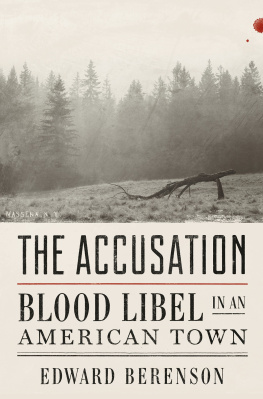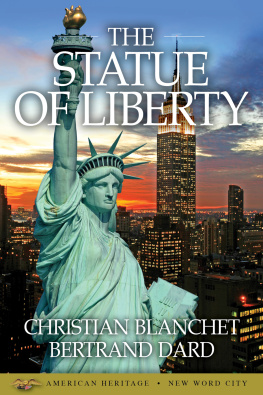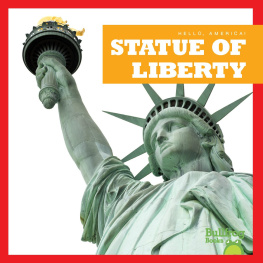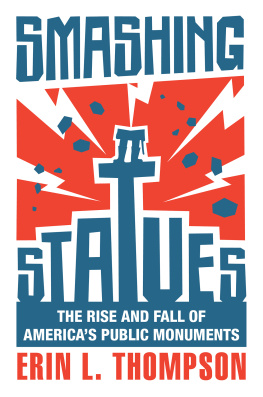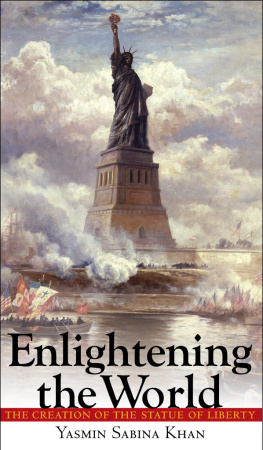Published with assistance from the foundation established in memory of Philip Hamilton McMillan of the Class of 1894, Yale College.
Copyright 2012 by Edward Berenson.
All rights reserved.
This book may not be reproduced, in whole or in part, including illustrations, in any form (beyond that copying permitted by Sections 107 and 108 of the U.S. Copyright Law and except by reviewers for the public press), without written permission from the publishers.
Yale University Press books may be purchased in quantity for educational, business, or promotional use. For information, please e-mail sales.press@ yale.edu (U.S. office) or sales@yaleup.co.uk (U.K. office).
Set in Janson type by Integrated Publishing Solutions. Printed in the United States of America.
Library of Congress Cataloging-in-Publication Data
Berenson, Edward, 1949
The Statue of Liberty : a transatlantic story / Edward Berenson.
p. cm.(Icons of America)
Includes bibliographical references and index.
ISBN 978-0-300-14950-0 (hardcover : alk. paper)
1. Statue of Liberty (New York, N.Y.)History. 2. Bartholdi, Frdric-Auguste, 18341904. 3. New York (N.Y.)Buildings, structures, etc.History. 4. United StatesRelationsFrance. 5. FranceRelationsUnited States. I. Title.
F128.64.L6B47 2012
974.71dc23
2011049636
A catalogue record for this book is available from the British Library.
This paper meets the requirements of ANSI/NISO Z39.48-1992 (Permanence of Paper).
10 9 8 7 6 5 4 3 2 1
I CONS OF A MERICA
Mark Crispin Miller, Series Editor
Icons of America is a series of short works written by leading scholars, critics, and writers, each of whom tells a new and innovative story about American history and culture through the lens of a single iconic individual, event, object, or cultural phenomenon.
The Hollywood Sign: Fantasy and Reality of an American Icon, by Leo Braudy
Joe DiMaggio: The Long Vigil, by Jerome Charyn
The Big House: Image and Reality of the American Prison, by Stephen Cox
Andy Warhol, by Arthur C. Danto
Our Hero: Superman on Earth, by Tom De Haven
Fred Astaire, by Joseph Epstein
Wall Street: Americas Dream Palace, by Steve Fraser
No Such Thing as Silence: John Cages 433, by Kyle Gann
Frankly, My Dear: Gone with the Wind Revisited, by Molly Haskell
Alger Hiss and the Battle for History, by Susan Jacoby
Nearest Thing to Heaven: The Empire State Building and American Dreams, by Mark Kingwell
Unwarranted Influence: Dwight D. Eisenhower and the Military-Industrial Complex, by James Ledbetter
The Liberty Bell, by Gary Nash
The Hamburger: A History, by Josh Ozersky
Gypsy: The Art of the Tease, by Rachel Shteir
Kings Dream, by Eric J. Sundquist
Jackson Pollock, by Evelyn Toynton
Inventing a Nation: Washington, Adams, Jefferson, by Gore Vidal
Bob Dylan: Like a Complete Unknown, by David Yaffe
Small Wonder: The Little Red Schoolhouse in History and Memory, by Jonathan Zimmerman
Acknowledgments
I wish to thank the wonderful archivists and librarians at the Conservatoire national des arts et mtiers in Paris. They were generous with their time and advice and helped me locate materials I would otherwise have missed. Im grateful to Ruth Harris, who read and commented on the entire manuscript. I wouldnt think of submitting a manuscript without having her read it first. Im thankful as well for Gary Nashs careful reading and astute advice about the text. (Any mistakes are, of course, my own.) Finally, Id like to acknowledge John Palmer and Jeffrey Schier for their fine editorial work; John Rambow, proofreader extraordinaire; and Sandy Dijkstra for everything.
I found several existing works crucial as I prepared my own, and Id like to acknowledge them here: Barry Moreno, The Statue of Liberty Encyclopedia (New York: Simon & Schuster, 2000); Pierre Provoyeur and June Hargrove, Liberty: The French-American Statue in Art and History (New York: Harper & Row, 1986); Marvin Trachtenberg, The Statue of Liberty (New York: Penguin, 1976); Robert Belot and Daniel Bermond, Bartholdi (Paris: Perrin, 2004); and Albert Boime, Hollow Icons: The Politics of Sculpture in 19th-Century France (Kent, Ohio: Kent State University Press, 1987).
As always, my greatest debt of gratitude is to my wife, Catherine Johnson, whose sharp intelligence and beautiful prose give me inspiration every day.
This book is dedicated to Catherine and to the memory of her parents, Robert Johnson (d. 2010) and Patricia Johnson (d. 2011), whose love, warmth, and generosity we will always miss.
The Statue of Liberty
Prologue
Its a cold March morning, and Im late for my 9:30 a.m. excursion to the Statue of Liberty. As I sprint toward the dock, hoping Ill make my boat, a solid wall of people stops me short. Hundreds, maybe thousands, of ticket holders are waiting to get onboard. The queue snakes around a maze of metal barriers; its destination is not the ferry but a huge bubble structure like those that cover tennis courts in chilly winter months. My ferry reservation is meaningless; its the security officers inside who determine when people get on.
Hats, belt, watches, wallets, coats, shoes. Hats, belts, watches, wallets, coats, shoes, I hear the officers chant as Im finally admitted to the security bubbles relative warmth. Ive spent a solid hour in the cold. About three million people visit Liberty Island every year, and even in winter theyre willing to stand patiently, sometimes an entire morning, in the brisk air of Battery Park. Another thirty minutes go by before Im finally invited to surrender my outerwear and metallic effects to the National Park Services security routine.
Its hard to imagine a more tempting terrorist target than the Statue of Liberty. To destroy Lady Liberty would be to strike at the symbolic heart of the United States. Its more than painful enough to contemplate a Manhattan skyline rendered toothless by Al Qaedas assault. Without the Statue of Liberty, New York Harbor would be damaged beyond emotional repair, a historical essence of America erased for good.
It would be a terrible loss not just for us, but also for the French, whose forebears had created the statue as a gift to the United States. One day, not long after 9/11, my then seven-year-old son was abruptly overcome by worry that someone would hit the statue next. What if terrorists fly an airplane into the Statue of Liberty, he asked my wife, his face betraying the fear that she would have no answer to give. As it turned out, he didnt need one. The French people are so nice, he said, they would make us a new one.


